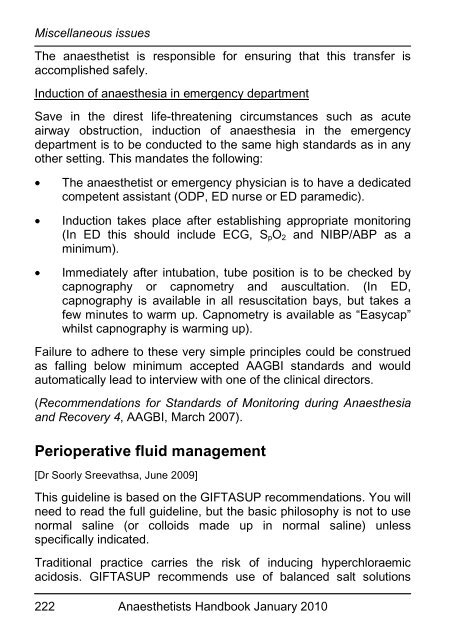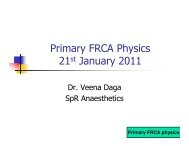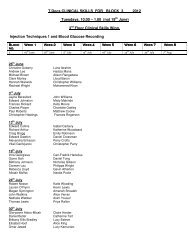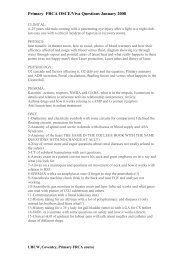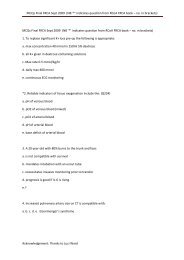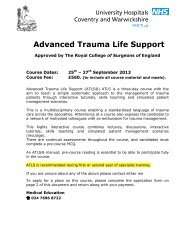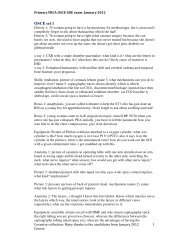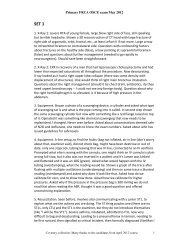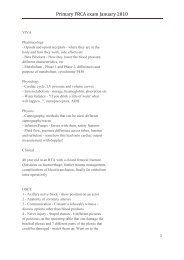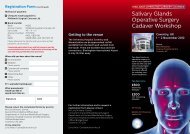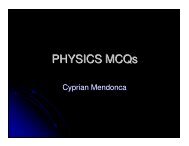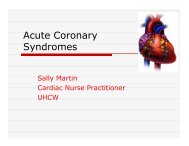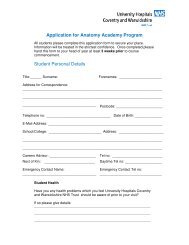- Page 1 and 2:
Department of AnaesthesiaAnaestheti
- Page 3 and 4:
Document control for approved clini
- Page 5 and 6:
ContentsTrauma list anaesthetist (t
- Page 7 and 8:
ContentsStudy leave 81Junior doctor
- Page 9 and 10:
ContentsIndications for investigati
- Page 11 and 12:
ContentsRenal patients - clinical g
- Page 13 and 14:
Introduction and scope of guideline
- Page 15 and 16:
Introduction and scope of guideline
- Page 17 and 18:
Airway assessmentManaging difficult
- Page 19 and 20:
Managing difficult airways• Flexi
- Page 21 and 22:
Managing difficult airways• Manuj
- Page 23 and 24:
Resuscitation - advanced life suppo
- Page 25 and 26:
Resuscitation - advanced life suppo
- Page 27 and 28:
Duties of the on call anaesthetists
- Page 29 and 30:
Duties of the on call anaesthetists
- Page 31 and 32:
Duties of the on call anaesthetists
- Page 33 and 34:
Duties of the on call anaesthetists
- Page 35 and 36:
Duties of the on call anaesthetists
- Page 37 and 38:
Duties of the on call anaesthetists
- Page 39 and 40:
Duties of the on call anaesthetists
- Page 41 and 42:
Duties of the on call anaesthetists
- Page 43 and 44:
Getting senior helpGetting senior h
- Page 45 and 46:
On call casesGetting senior helpYou
- Page 47 and 48:
Supervision for sick patientsGettin
- Page 49 and 50:
Calling the senior resident anaesth
- Page 51 and 52:
Perianaesthesia Care Unit (PACU)PAC
- Page 53 and 54:
PACUThe surgical team responsible f
- Page 55 and 56:
PACU6. Oxygen and intravenous thera
- Page 57 and 58:
Integration with the critical care
- Page 59 and 60:
Inter-hospital transfersInter-hospi
- Page 61 and 62:
Inter-hospital transfersConsultant
- Page 63 and 64:
Signing onAdministrative issuesYour
- Page 65 and 66:
Administrative issuesMobile phones
- Page 67 and 68:
Administrative issuesobstetrics, we
- Page 69 and 70:
Administrative issuesMain theatre r
- Page 71 and 72:
CLWrota processes• To complete ca
- Page 73 and 74:
Security rules:• Do not put confi
- Page 75 and 76:
Education and trainingthe Royal Col
- Page 77 and 78:
Education and trainingthe necessary
- Page 79 and 80:
Education and trainingarrive in the
- Page 81 and 82:
Education and traininginformation c
- Page 83 and 84:
Education and trainingexamination i
- Page 85 and 86:
Education and trainingAll consultan
- Page 87 and 88:
Presenting at seminars• Bring har
- Page 89 and 90:
Presenting at seminarsDOI advise yo
- Page 91 and 92:
Clinical adverse event reportingCli
- Page 93 and 94:
Clinical auditClinical audit[Apprai
- Page 95 and 96:
Clinical auditYour presentation sho
- Page 97 and 98:
Pain management and postoperative c
- Page 99 and 100:
Pain management and postoperative c
- Page 101 and 102:
Pain management and postoperative c
- Page 103 and 104:
Pain management and postoperative c
- Page 105 and 106:
Pain management and postoperative c
- Page 107 and 108:
Pain management and postoperative c
- Page 109 and 110:
Pain management and postoperative c
- Page 111 and 112:
Pain management and postoperative c
- Page 113 and 114:
Pain management and postoperative c
- Page 115 and 116:
Pain management and postoperative c
- Page 117 and 118:
Pain management and postoperative c
- Page 119 and 120:
Pain management and postoperative c
- Page 121 and 122:
Signs and symptomsAgitation, anxiet
- Page 123 and 124:
Epidural anaesthesia and analgesiaP
- Page 125 and 126:
Epidural anaesthesia and analgesiai
- Page 127 and 128:
Epidural anaesthesia and analgesiaS
- Page 129 and 130:
IndicationsEpidural anaesthesia and
- Page 131 and 132:
Epidural anaesthesia and analgesiaH
- Page 133 and 134:
Assessment and treatment optionsEpi
- Page 135 and 136:
Epidural anaesthesia and analgesia3
- Page 137 and 138:
Epidural anaesthesia and analgesia
- Page 139 and 140:
Epidural anaesthesia and analgesiaA
- Page 141 and 142:
Epidural anaesthesia and analgesiaG
- Page 143 and 144:
Allergies and adverse drug reaction
- Page 145 and 146:
Allergies and adverse drug reaction
- Page 147 and 148:
Allergies and adverse drug reaction
- Page 149 and 150:
Awareness during anaesthesiaPrevent
- Page 151 and 152:
Fractured neck of femur:management
- Page 153 and 154:
Fractured neck of femurGuidelines f
- Page 155 and 156:
Management of patients with diabete
- Page 157 and 158:
Patients who take insulinManagement
- Page 159 and 160:
Management of patients with diabete
- Page 161 and 162:
Management of patients with diabete
- Page 163 and 164:
Preoperative assessment and investi
- Page 165 and 166:
Preoperative assessment and investi
- Page 167 and 168:
Indications for investigationsFull
- Page 169 and 170:
Preoperative assessment and investi
- Page 171 and 172: SevofluraneSevoflurane[Dr Mark Port
- Page 173 and 174: Sevofluranemust be considered on it
- Page 175 and 176: Gabapentin in acute painSide-effect
- Page 177 and 178: Blood and blood productsBlood and b
- Page 179 and 180: Blood and blood productsWhen the un
- Page 181 and 182: Blood and blood productsCross match
- Page 183 and 184: Blood and blood productsBlood Cool
- Page 185 and 186: Blood and blood productsHaematology
- Page 187 and 188: Blood and blood products25322 so th
- Page 189 and 190: Blood and blood productsfactors, ha
- Page 191 and 192: Day case anaesthesia6. Social crite
- Page 193 and 194: ENT anaesthesiaENT anaesthesia{Dr C
- Page 195 and 196: ENT anaesthesiaIntraoperative• In
- Page 197 and 198: Miscellaneous issuesMiscellaneous i
- Page 199 and 200: Miscellaneous issuesideally be cont
- Page 201 and 202: Miscellaneous issuesinstruction man
- Page 203 and 204: Miscellaneous issuesRemifentanilRem
- Page 205 and 206: Miscellaneous issuesCentral neuraxi
- Page 207 and 208: Miscellaneous issuesAnalgesia Fenta
- Page 209 and 210: Miscellaneous issues• Diclofenac
- Page 211 and 212: Miscellaneous issues• Associated
- Page 213 and 214: Miscellaneous issues• Everyone wi
- Page 215 and 216: Miscellaneous issues• If fasting
- Page 217 and 218: Miscellaneous issueslabour ward ana
- Page 219 and 220: Miscellaneous issuesThere is no cli
- Page 221: Patient monitoring in and out of th
- Page 225 and 226: Miscellaneous issues• Abdominal a
- Page 227 and 228: Miscellaneous issuesPrevention of p
- Page 229 and 230: Miscellaneous issuesDifferent clini
- Page 231 and 232: Recovery and patient handoverMiscel
- Page 233 and 234: For afternoon list (pm)Diabetic Pat
- Page 235 and 236: Miscellaneous issuestake part in th
- Page 237 and 238: Miscellaneous issuesSee page 37 for
- Page 239 and 240: Waiting list initiatives[Appraised
- Page 241 and 242: Major Incident ProcedureStaff assem
- Page 243 and 244: Major Incident Procedure• In coop
- Page 245 and 246: Finding your way round theUniversit
- Page 247 and 248: • Coffee room.• Quiet room (fiv
- Page 249 and 250: Anaesthesia department lead clinici
- Page 251 and 252: Trust organisational structureTrust
- Page 253 and 254: Telephone numbersLabour ward……
- Page 255 and 256: IndexIndexAabsence, 68adenotonsille
- Page 257 and 258: Indexemergency department, 222emerg
- Page 259 and 260: Indexmortality review, 93MRI scansa
- Page 261 and 262: Indexstudy leave, 81applications, 6
- Page 263 and 264: NotesAnaesthetists Handbook January
- Page 265: NotesAnaesthetists Handbook January


